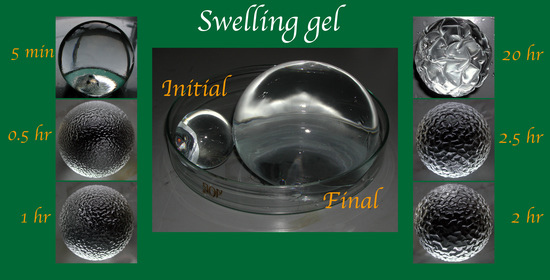Phase Transition of Gels—A Review of Toyoich Tanaka’s Research
Abstract
:1. Introduction
2. Equilibrium Property of Gel
2.1. Discovery of the Volume Phase Transition of Gel
2.2. How the Volume Phase Transition of the Gel Occurs
2.2.1. Analogy with the Gas-Liquid Phase Transition
2.2.2. Analogy with the Gas-Liquid Phase Transition
- Osmotic pressure due to the rubber elasticity; .
- Osmotic pressure due to the interaction between polymer and solvent; .
- Osmotic pressure of counter ions; .
- Osmotic pressure due to the mixing entropy; .
2.2.3. Theoretical Swelling Curve of Gel
2.2.4. Critical Conditions for Discontinuous Volume Phase Transition
2.2.5. Volume Phase Transition in Various Gels
- Van der Waals interaction.
- Hydrophobic interaction.
- Hydrogen bond.
- Electrical interaction between charges.
3. Dynamic Property of Gel
3.1. Collective Diffusion of Polymer Network
3.2. Swelling Behavior
3.3. Light Scattering from Collective Mode of Gel
3.4. Critical Phenomena
4. Concluding Remarks
Funding
Institutional Review Board Statement
Informed Consent Statement
Acknowledgments
Conflicts of Interest
References
- Flory, P.J. Principles of Polymer Chemistry; Cornell University Press: Ithaca, NY, USA, 1953. [Google Scholar]
- Katchalsky, A.; Lifson, S.; Eisenberg, H. Equation of swelling for polyelectrolyte gels. J. Polym. Sci. 1951, 7, 571–574. [Google Scholar] [CrossRef]
- Thurmond, C.D.; Zimm, B.H. Size and shape of the molecules in artificially branched polystyrene. J. Polym. Sci. 1952, 8, 476–494. [Google Scholar] [CrossRef]
- Hill, L.T. Some statistical mechanical models of elastic polyelectrolytes and proteins. J. Chem. Phys. 1952, 20, 1259–1273. [Google Scholar] [CrossRef]
- Dusek, K.; Patterson, D. Transition in swollen polymer networks induced by intramolecular condensation. J. Polym. Sci. 1968, 6 Pt A-2, 1209–1216. [Google Scholar] [CrossRef]
- Tanaka, T. Collapse of gels and the critical end point. Phys. Rev. Lett. 1978, 40, 820–823. [Google Scholar] [CrossRef]
- Tanaka, T.; Fillmore, D.J.; Sun, S.-T.; Nishio, I.; Swislow, G.; Shah, A. Phase transition in ionic gels. Phys. Rev. Lett. 1980, 45, 1636–1639. [Google Scholar] [CrossRef]
- Tanaka, T. Gerunosouteni. Bull. Phys. Soc. Jpn. 1986, 41, 542–552. [Google Scholar]
- Hirokawa, Y.; Tanaka, T. Volume phase transition in a nonionic gel. J. Chem. Phys. 1978, 81, 6379–6380. [Google Scholar] [CrossRef]
- Hirotsu, S.; Hirokawa, Y.; Tanaka, T. Volume-phase transitions of ionized N-isopropylacrylamide gels. J. Chem. Phys. 1987, 87, 1392–1395. [Google Scholar] [CrossRef]
- Hirokawa, Y.; Tanaka, T.; Sato, E. Phase transition of positively ionized gels. Macromolecules 1985, 18, 2782–2784. [Google Scholar] [CrossRef]
- Tanaka, T.; Fillmore, J.D. Kinetics of swelling of gel. J. Chem. Phys. 1979, 70, 1214–1218. [Google Scholar] [CrossRef]
- Tanaka, T.; Sato, E.; Hirokawa, Y.; Hirotsu, S.; Peetermans, J. Critical kinetics of volume phase transition of gels gels. Phys. Rev. Lett. 1985, 55, 2455–2458. [Google Scholar] [CrossRef] [PubMed]
- Tanaka, T.; Hocker, L.O.; Benedeek, G.B. Spectrum of light scatterd from a viscoelastic gel. J. Chem. Phys. 1973, 59, 5151–5159. [Google Scholar] [CrossRef]
- Tanaka, T.; Ishiwata, S.; Ishimoto, C. Critical behavior of density fluctuations in gels. Phys. Rev. Lett. 1977, 38, 771–774. [Google Scholar] [CrossRef]
- Tanaka, T. Dynamics of critical concentration fluctuations in gel. Phys. Rev. 1978, A17, 763–766. [Google Scholar] [CrossRef]
- Tokita, M.; Tanaka, T. Friction coefficient of polymer network of gel. J. Chem. Phys. 1991, 95, 4613–4619. [Google Scholar] [CrossRef]
- Tokita, M.; Tanaka, T. Reversible decrease of gel-solvent friction. Science 1991, 253, 1121–1123. [Google Scholar] [CrossRef]
- Onuki, A. Phase Transition Dynamics; Cambridge University Press: Cambridge, UK, 2002. [Google Scholar] [CrossRef]
- Tanaka, T.; Sun, S.-T.; Hirokawa, Y.; Katayama, S.; Kucera, J.; Hirose, Y.; Amiya, T. Mechanical instability of gels at the phase transition. Nature 1987, 325, 796–798. [Google Scholar]
- Matsuo, E.S.; Tanaka, T. Patterns in shrinking gels. Nature 1992, 358, 482–485. [Google Scholar]
- Tokita, M.; Suzuki, S.; Miyamoto, K.; Komai, T. Confocal laser scanning microscope imaging of a pattern in shrinking gel. J. Phys. Soc. Jpn. 1999, 68, 330–333. [Google Scholar] [CrossRef]
- Tokita, M.; Miyamoto, K.; Komai, T. Polymer network dynamics in shrinking patterns of gels. J. Chem. Phys. 2000, 113, 1647–1650. [Google Scholar] [CrossRef]
- Annaka, M.; Tanaka, T. Multiple phases of polymer gels. Nature 1992, 355, 430–432. [Google Scholar] [CrossRef]
- Pande, V.S.; Grosberg, A.Y.; Tanaka, T. Thermodynamic procedure to synthesize heteropolymers that can renature to recognize a given target molecule. Proc. Natl. Acad. Sci. USA 1994, 91, 12976–12979. [Google Scholar] [CrossRef] [PubMed]
- Pande, V.S.; Grosberg, A.Y.; Tanaka, T. Statistical mechanics of simple models of protein folding and design. Biophys. J. 1997, 73, 3192–3210. [Google Scholar] [CrossRef]
- Oya, T.; Enoki, T.; Grosberg, A.Y.; Masamune, S.; Sekiyama, T.; Takeoka, Y.; Tanaka, K.; Wang, G.; Yilmaz, Y.; Feld, M.S.; et al. Reversible molecular adsorption based on multiple-point interaction by shrinkable gels. Science 1999, 286, 1543–1545. [Google Scholar] [CrossRef]
- Enoki, T.; Tanaka, K.; Watanabe, T.; Oya, T.; Sakiyama, T.; Takeoka, Y.; Ito, K.; Wang, G.; Annaka, M.; Hara, K.; et al. Frustrations in polymer conformation in gels and their minimization through molecular imprinting. Phys. Rev. Lett. 2000, 85, 5000–5003. [Google Scholar] [CrossRef] [Green Version]










Publisher’s Note: MDPI stays neutral with regard to jurisdictional claims in published maps and institutional affiliations. |
© 2022 by the author. Licensee MDPI, Basel, Switzerland. This article is an open access article distributed under the terms and conditions of the Creative Commons Attribution (CC BY) license (https://creativecommons.org/licenses/by/4.0/).
Share and Cite
Tokita, M. Phase Transition of Gels—A Review of Toyoich Tanaka’s Research. Gels 2022, 8, 550. https://doi.org/10.3390/gels8090550
Tokita M. Phase Transition of Gels—A Review of Toyoich Tanaka’s Research. Gels. 2022; 8(9):550. https://doi.org/10.3390/gels8090550
Chicago/Turabian StyleTokita, Masayuki. 2022. "Phase Transition of Gels—A Review of Toyoich Tanaka’s Research" Gels 8, no. 9: 550. https://doi.org/10.3390/gels8090550




